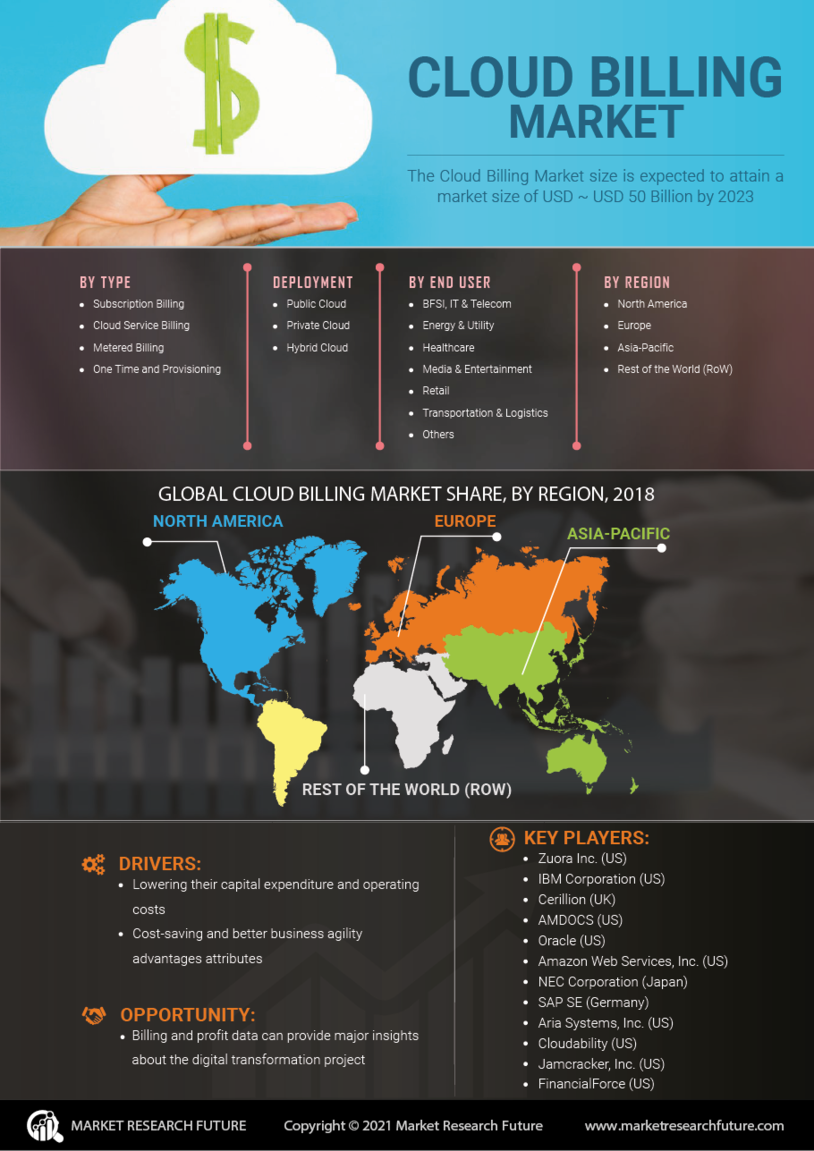Rising Adoption of Cloud Services
The increasing adoption of cloud services across various sectors is a primary driver for the Cloud Billing Market. Organizations are migrating to cloud-based solutions to enhance operational efficiency and reduce costs. According to recent data, the cloud services market is projected to reach a valuation of over 800 billion dollars by 2025. This surge in cloud adoption necessitates robust billing solutions to manage subscriptions and usage-based pricing models effectively. As businesses seek to optimize their cloud expenditures, the demand for sophisticated billing systems that can provide real-time analytics and reporting is likely to grow. Consequently, this trend is expected to propel the Cloud Billing Market forward, as companies require reliable billing solutions to support their cloud strategies.
Shift Towards Usage-Based Pricing Models
The shift towards usage-based pricing models is significantly influencing the Cloud Billing Market. As organizations increasingly prefer flexible payment structures that align costs with actual usage, billing solutions must adapt to accommodate these models. This trend is particularly evident in sectors such as telecommunications and software as a service (SaaS), where companies are moving away from traditional flat-rate pricing. Market data indicates that the SaaS segment alone is expected to grow at a compound annual growth rate of over 20% through 2025. This evolution in pricing strategies necessitates advanced billing systems capable of tracking usage metrics accurately and generating invoices accordingly. Therefore, the Cloud Billing Market is likely to experience heightened demand for innovative billing solutions that can support these dynamic pricing models.
Increased Focus on Financial Transparency
The growing emphasis on financial transparency within organizations is driving the Cloud Billing Market. Companies are increasingly required to provide clear and detailed billing information to stakeholders, including customers and regulatory bodies. This demand for transparency is particularly pronounced in industries such as finance and healthcare, where compliance with stringent regulations is paramount. As organizations strive to enhance their financial reporting and accountability, the need for comprehensive billing solutions that offer detailed insights into cloud expenditures becomes critical. Market analysis suggests that the demand for billing solutions that facilitate transparency and compliance is likely to rise, thereby propelling the Cloud Billing Market forward. Enhanced reporting capabilities and audit trails are becoming essential features in billing systems to meet these evolving requirements.
Growing Need for Multi-Cloud Management Solutions
The rising trend of multi-cloud strategies among organizations is a significant driver for the Cloud Billing Market. As businesses adopt multiple cloud service providers to avoid vendor lock-in and enhance flexibility, the complexity of managing billing across different platforms increases. This complexity necessitates the development of integrated billing solutions that can consolidate billing information from various cloud services into a single interface. Market data suggests that the multi-cloud market is expected to grow substantially, with a projected value exceeding 200 billion dollars by 2025. This growth indicates a pressing need for billing systems that can handle diverse pricing models and provide comprehensive visibility into cloud expenditures. Therefore, the Cloud Billing Market is poised to expand as organizations seek effective solutions to manage their multi-cloud environments.
Integration of Artificial Intelligence and Automation
The integration of artificial intelligence (AI) and automation technologies is transforming the Cloud Billing Market. AI-driven billing solutions can analyze vast amounts of data to optimize pricing strategies and improve customer experiences. Automation streamlines billing processes, reducing manual errors and enhancing efficiency. As organizations seek to leverage technology for competitive advantage, the demand for AI-enabled billing systems is expected to increase. Market forecasts indicate that the AI in the billing sector could witness a growth rate of over 30% by 2025. This technological advancement not only enhances operational efficiency but also provides organizations with valuable insights into customer behavior and spending patterns. Consequently, the Cloud Billing Market is likely to benefit from the adoption of these innovative technologies, leading to more sophisticated and responsive billing solutions.


















Leave a Comment